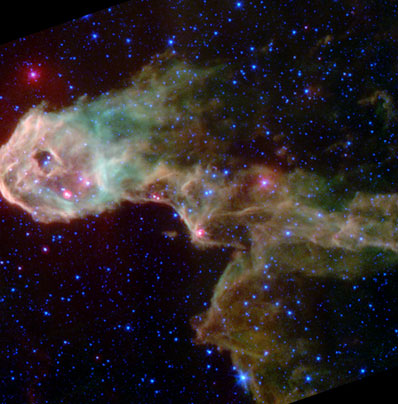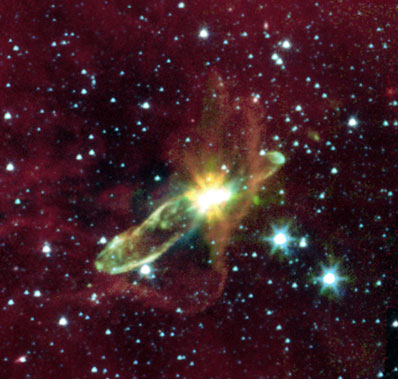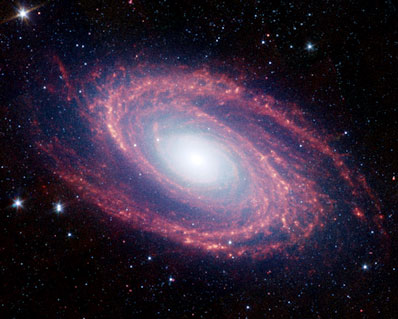Astronomy Picture of the Day
Discover the cosmos! Each day a different image or photograph of our fascinating universe is featured, along with a brief explanation written by a professional astronomer.
Posted on 12/19/2003 5:22:18 AM PST by petuniasevan
Discover the cosmos! Each day a different image or photograph of our fascinating universe is featured, along with a brief explanation written by a professional astronomer.
Explanation: Spectacular first images from the newly christened Spitzer Space Telescope include this penetrating interior view of an otherwise opaque dark globule known as the Elephant's Trunk Nebula. Seen in a composite of infrared image data recorded by Spitzer's instruments, the intriguing region is embedded within the glowing emission nebula IC 1396 at a distance of 2,450 light-years toward the constellation Cepheus. Previously undiscovered protostars hidden by dust at optical wavelengths appear as bright reddish objects within the globule. Shown in false-color, winding filaments of infrared emission span about 12 light-years and are due to dust, molecular hydrogen gas, and complex molecules called polycyclic aromatic hydrocarbons or PAHs. The Spitzer Space Telescope was formerly known as the Space Telescope Infrared Facility (SIRTF) and is designed to explore the Universe at infrared wavelengths. Spitzer follows the Hubble Space Telescope, the Compton Gamma-ray Observatory, and the Chandra X-ray Observatory as the final element NASA's space-borne Great Observatories Program.
Oh, this new 'scope's images are fantastic! By all means check out the images and video clips on THIS PAGE!
NASA unveiled the first images from the $670 million Spitzer Space Telescope today, spectacular infrared glimpses of the optically-hidden heart of a distant galaxy, the dusty cradle of an infant solar system and a peek at heretofore unseen stars lurking inside a vast cloud of gas and dust.
 Protostars uncovered in multiple views of dark globule in IC1396. Credit: NASA/JPL-Caltech/W. Reach (SSC/Caltech) |
"Those are the building blocks that go into assembling larger and larger organic molecules, the process that eventually [can] lead to life," said James Houck, a principal investigator from Cornell University. "That's a tremendous result."
Especially since it took the new telescope just 14 minutes to collect the data.
"What are we going to be able to accomplish in five years?" Houck asked. "We're going to be able to see things that make this look like ho hum. It's the enormous sensitivity of the Spitzer Space Telescope, and its wide wavelength coverage, that are the features that are going to make it a killer mission. We can expect a flood of discovery over the next five years. A flood."
John Bahcall of the Institute for Advanced Study chaired a panel in 1991 that concluded a large infrared telescope was the top priority for astronomy in the decade of the 90s. At a news conference today, he said the first images from the newly named Spitzer Space Telescope represented the dawn of yet another astronomical revolution.
"Today we open our eyes for the first time on a new universe," he said. "With the help of the Spitzer Space Telescope, we can see things that human beings couldn't see before. We can watch stars being born, we can see planets form, we can observe galaxies shrouded in dust, we can look to the edge of the visible universe."
 Embedded outflows from Herbig-Haro 46/47. Credit: NASA/JPL-Caltech/A. Noriega-Crespo (SSC/Caltech), Digital Sky Survey |
"Many secrets are hidden in the infrared. But ... observations with the Spitzer Telescope can unveil a beautiful spiral galaxy and show where the mass and the stars are concentrated. Beginning today, it will no longer be possible to characterize a system by its optical light. ... In order to understand how things operate in the heavens, we will need all of the colors and the Lyman Spitzer Space Telescope, along with other telescopes, will make that possible."
NASA's fourth and final "great observatory," originally known as the Space Infrared Telescope Facility and renamed today in honor of astronomer Lyman Spitzer, was launched Aug. 25. To achieve the ultra-low operating temperatures required to detect faint infrared radiation from deep space objects, the telescope was boosted into an orbit around the sun that's slightly larger than Earth's.
Equipped with a solar panel that doubles as a huge sunshade, the telescope's digital cameras are chilled to a few degrees above absolute zero. The observatory is so well shaded and insulated, only about an ounce of liquid helium coolant per month is required to maintain the desired operating temperature. If all goes well, engineers say, the helium should last for nearly six years.
 An artist's concept of the Spitzer Space Telescope. Credit: NASA/JPL/Caltech |
It took two months for the telescope to cool down to operational temperatures and for scientists to check out and calibrate the instruments. Only then did they begin taking the pictures that were unveiled today at a news conference at NASA headquarters in Washington.
"For me and, I think, all astronomers, today seems very much like a dream come true," Bahcall said. "It's clear that the telescope is performing beyond our expectations, we are getting more science than expected for fewer public dollars."
The new observatory is expected to beam back 8 gigabytes of data per day - the equivalent of 20,000 observations per year - over the life of the program. It is 100 to 1,000 times more sensitive than any previous infrared space telescope.
The images released today were intended to demonstrate the telescope's health and capabilities as well provide new insights into a variety of cosmic processes. The most spectacular image, to this writer at least, was a shot of galaxy M-81, a spiral starswarm 12 million light years from Earth.
 Short-wavelength infrared view of spiral galaxy Messier 81. Credit: NASA/JPL-Caltech/S. Willner (Harvard-Smithsonian Center for Astrophysics) |
"For the first time, the Spitzer Space Telescope allows us to dissect a galaxy into its component parts just like a kid in a biology lab is dissecting a frog," said Giovanni Fazio, a principal investigator at the Harvard-Smithsonian Center for Astrophysics. "This is something we've never been able to do before and it will change the way we classify galaxies."
As for mapping the distribution of organic molecules in distant galaxies, Houck said it's too soon to say what the presence of such material might mean for the evolution of life elsewhere.
"The implications for life are totally uncertain," he said. "What we see is a bunch of building blocks, a bunch of bolts, some screws, maybe a horn button. That doesn't mean a car is going to appear soon, it just means there are a lot of pieces that are characteristic of the pieces that must have gone into building a car. So predicting life on the basis of the evidence we have now, I think, is going very far out on a limb. But we're ahead of the game. We've fond the molecules are present."
Bahcall agreed.
"All of us are interested in the origin of life," he said. "All of us are interested in how the universe that we inhabit got to be the way it is. To be honest, we don't have all the answers now. But with the advent of the Spitzer Space Telescope, we are a lot closer than we have ever been before. I am thrilled, thrilled to hear about the discovery of organic molecules in a distant galaxy at a time when the Earth was in its infancy."

michael miserable failure moore hillary evil bitch clinton al sore loser gore bill lying rapist clinton
More facts. More science may result. Just give me the facts.
-Friday
Disclaimer: Opinions posted on Free Republic are those of the individual posters and do not necessarily represent the opinion of Free Republic or its management. All materials posted herein are protected by copyright law and the exemption for fair use of copyrighted works.